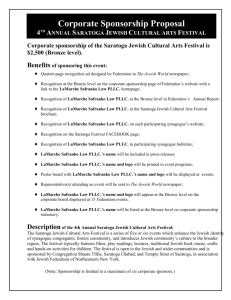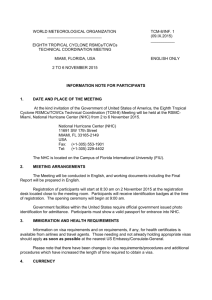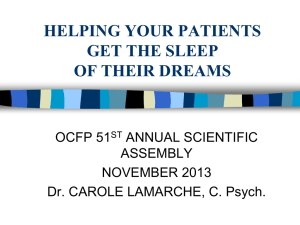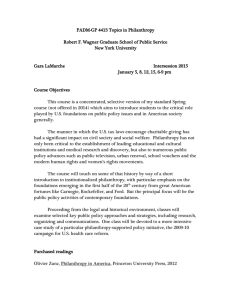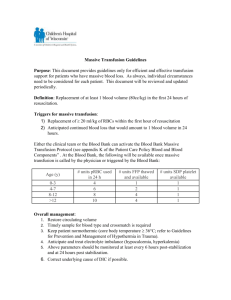Hematology in the ICU - UBC Critical Care Medicine, Vancouver BC
advertisement
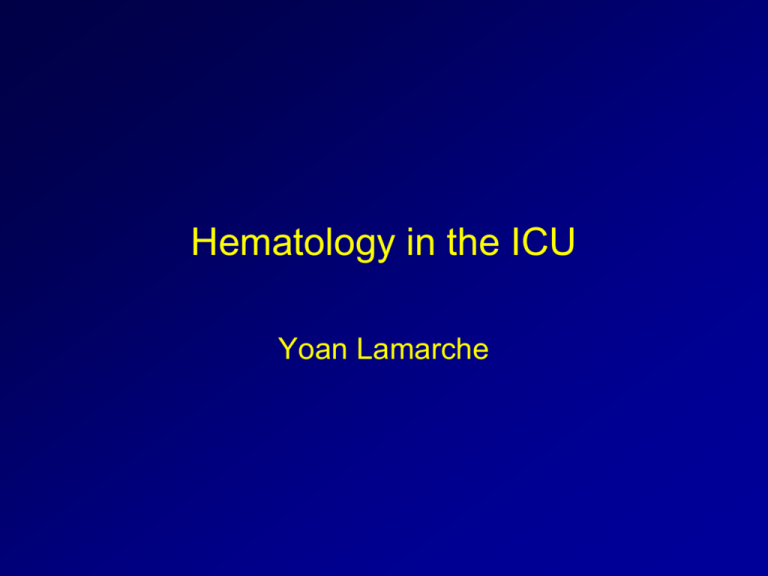
Hematology in the ICU Yoan Lamarche • A 42 yo patient presents to the ER 3 weeks after allogenic hematopoietic stem cell transplant for acute myeloid leukemia. His principal complaint is fever and cough. 1. Classify hematologic malignancies and outline the principles of treatment. (Noemie) Yoan Lamarche Principles of treatment • Radiation • Can be used alone in stage 1A Hodgkin Lymphoma • In Combination therapy for initial bulky sites to tumor burden • Used for solitary plasmacytoma in MM • Chemotherapy • Induction Rx • Complete Remission (eg. Normal CBC & <5% BM blast in AML) • Consolidation Rx • Intrathecal chemo: eg. ALL • Biologics: • eg. interferon, Imatinib (BCR/ABL inhibitor for CML) Yoan Lamarche Principles of treatment • Bone Marrow Transplant – Source of cells: bone marrow, peripheral blood or umbilical cord blood – Auto: Donor is also recipient • No GVHD • Allows higher doses of chemo • Used for lymphoma and MM – Allo: Immunologically distinct • • • • Used for AML, ALL, CML, CLL, MDS, lymphoma Used in nonmalignant diseases: eg.Aplastic anemia Desired effect of Graft vs tumor BUT risk of GVHD Followed by immunosuppression to prevent rejection Yoan Lamarche 2. What are the complications of hematopoietic stem cell transplant leading to ICU admission (Todd) 3. Explain the principles of treatment of infectious and non infectious complications of hematopoietic stem cell transplant. (Todd) Yoan Lamarche Life-threatening complications of HSCT • Non-infectious – Cardiogenic pulmonary edema • From chemo conditioning (cyclophosphamide) or chronic chemo (anthracycline) • Pericarditis (+/- tamponade or arrhythmias) from radiation – Noncardiogenic pulmonary edema • Diffuse Alveolar Damage (analogous to ARDS) Yoan Lamarche Life-threatening complications of HSCT, continued • Diffuse Alveolar Hemorrhage – Rarely with gross hemoptysis; usually progressive hypoxia, dyspnea, tachycardia within 2 weeks of HSCT – CXR --> patchy interstitial +/- airspace opacification, initially involving mid-zones, spreading outward – Dx is with bronchoscopy, where progressively bloodier returns are noted with repeated BAL – Pathophysiology: ??? Pre-transplant airway inflammation – High mortality (up to 90%) – Treatment: Pulse steroids (according to a retrospective study in 1994…) Yoan Lamarche Life-threatening complications of HSCT, continued • Interstitial lung disease (usually associated with aggressive chemo, including cyclophosphamide, doxorubicin and cisplatin) • Pneumonitis: – Aspiration (ie mucositis and opiates) – Idiopathic interstitial pneumonitis and ARDS or fibrosis (high mortality) • Non-pulmonary: Hepatic veno-occlusive disease (may --> fulminant hepatic failure) Yoan Lamarche Infectious complications • Preengraftment as well as immediately and late (> 3 mo) postengraftment • Bacterial, fungal and viral pathogens lie in wait at each stage. • Immunosuppression (including neutropenia) is the key factor – Including chemo conditioning period Yoan Lamarche The Usual Suspects • • • Bacterial: – Aerobic gram positive and gram-negative organisms • Psuedomonas (<1% of allogeneic SCT pts), legionella and bacillus in particular Fungal: – Candida (mucocutaneous or invasive) and aspergillus are most common • Fusarium, zygoycetes, and others are increasingly recognized Viral: – CMV (pneumonia, enteritis, retinitis, encephalitis, marrow suppression, FUO…) – HSV (VZV late postengraftment) – HHV 6, 7,8 (fever, pneumonitis, encephalitis) – EBV (pneumonia) – Adenovirus (pneumonitis, nephritis, hemorrrhagic colitis, hemorrhagic cystitis) Yoan Lamarche The Usual Suspects (don’t forget Verbal Kint) • Parasitic: – PCP (or PJP), rare due to chemoprophylaxis – Toxopasmosis – Mycobacteria (TB, avum) Yoan Lamarche Yoan Lamarche Yoan Lamarche Yoan Lamarche Yoan Lamarche DAHHemosiderin laden macrophages Yoan Lamarche Yoan Lamarche Yoan Lamarche Prophylaxis • Viral: Acyclovir through day 30 (HSV), gancyclovir through day 100 (CMV) • Bacterial: Quinolone during neutropenia • Fungal: Fluconazole through day 75 (candida) • Parasitic: TMP/SMX through day 180 or end of immunosuppression (PCP) Yoan Lamarche Quinolone x neutropenic phase Fluconazole x 75d Acyclovir 30d TMP/SMX x 180d or end immmunosupp Gancyclovir 100d vs PCR q week On initial assessment, the patient is anxious and coughing, his RR is 30 and HR 110, his BP is 95/40, he is 38ºC, O2 Sat is 88% on RA after administration of 2L NS by the emergency team. Yoan Lamarche The patient is admitted to the ICU for observation, investigation and treatment 4. What should be the initial workup and choice of Rx (Todd) Yoan Lamarche Treatment • Low threshold for broad spectrum coverage, especially in critical care setting. Keep presenting syndrome in mind, but be prepared to jump on septic immunosuppressed patients like a spider monkey. Yoan Lamarche For our patient • Early postengraftment (i.e. immunosuppressed), with pulmonary sepsis syndrome (RR, Temp, HR). – Prophylaxis, chemo and CBC/Diff unknown • Initial broad coverage to include gram positive/negative bacteria (including psuedomonas – Imipenem 500 mg IV Q 6 hrs – Add antifungal or antiviral if no improvement by day 5, or if clinical picture evolves to suggest these pathogens Yoan Lamarche For our patient, continued • Investigations: Pan-culture (not CSF at this point, but would have low threshold to LP if LOC changes or neurological complaints develop) • Imaging: CXR initially Yoan Lamarche Tube? • Goal directed therapy as with any other septic patient, with careful consideration of possible cardiomyopathy in setting of chemo • Decision to intubate would be similar to any other septic patient; the poor outcome associated with multiorgan failure in this population would warrant consultation with heme regarding his prognosis (nb recent pt in SPH ICU) Yoan Lamarche Yoan Lamarche Shorr, Pulmonary Infiltrates in the Non-HIV- Infected Immunocompromised Patient CHEST / 125/1/ JANUARY 2004 Yoan Lamarche The patient is now in your ICU. His Sat is better with O2, his RR is now 25 and less labored. His CBC indicates Hb of 82, Plt of 19 000 and WBC count of 2, Creat is 200 and LFTs indicate N AST/ALT, Total Bilirubin is 100, Direct bili is 12, GGT N, LDH 200 . The patient has a urine output of 20 cc/hr for the first 2 hours, the patient appears more confused and complains of blurred vision. 5. What are the possible diagnoses leading to this constellation of symptoms (Noemie) Yoan Lamarche Q#5 What are the possible diagnoses leading to this constellation of symptoms? • 42 yo 3 wks post ABMT for AML presents with fever and cough • Becomes more confused and complaining of blurred vision • T 38, RR 25, u/o 20 cc/hr in 2 hours • Hb 82, Plt 19, WBC 2, Cr 200, AST/ALT N, T.Bili 100, D.Bili 12, GGT N, LDH 200 Yoan Lamarche Q#5 What are the possible diagnoses leading to this constellation of symptoms? • 42 yo 3 wks post ABMT for AML presents with fever and cough • Becomes more confused and complaining of blurred vision(?) • T 38, RR 25, u/o 20 cc/hr in 2 hours • Hb 82, Plt 19, WBC 2, Cr 200, AST/ALT N, T.Bili 100, D.Bili 12, GGT N, LDH 200 Yoan Lamarche What are the possible diagnoses leading to this constellation of symptoms? • Fever in post BMT – ?infection, ?drug fever, ?TTP, rejection? • Renal failure – ?Pre-renal, microvascular, toxins/meds, ATN • Hemolysis – Transfusion reaction (Combs?), TTP?, DIC? • Acute blurry vision – ?retinal detachment, neuritis, retinal vascular occlusion, uveitis, acute glaucoma • Cytopenia – ?rejection, hemolysis, malignancy, DIC/sepsis Yoan Lamarche What are the possible diagnoses leading to this constellation of symptoms? • DDX: – TTP: classical pentad – DIC ? Coags, ? Fibrinogen – Transfusion rxn ? Combs, blurry vision uncommon – GVHD no mucositis, ?hemolysis and blurry vision uncommon Yoan Lamarche 6. What are the risk factors associated with development of TTP (Scot) Yoan Lamarche Yoan Lamarche 5. What is the physiopathology of TTP (Naisan) Yoan Lamarche Yoan Lamarche Yoan Lamarche TTP blood smear Yoan Lamarche 5. What are the diagnostic criteria for TTP (Naisan) Yoan Lamarche An update on the pathogenesis and management of acquired thrombotic thrombocytopenic purpura Helen Yarranton and Samuel J. Machin. Curr Opin Neurol 16:367–373. Yoan Lamarche Yoan Lamarche 5. Explain the treatment modalities for TTP, what is the outcome after treatment, are there reports of recurrence (Scot) Yoan Lamarche • PLEX – infusion presumably supplies missing ADAMTS-13 protease, and exchange removes any acquired autoantibody and unusually large VWF multimers. – Schedule – initially daily until platelet count has normalized and hemolysis has ceased. – Recommended volume is one plasma volume. • Adjunctive treatments – steroids, immunosupressants (rituximab, cyclosporine) may reduce production of autoantibodies in poorly responsive, relapsing or resistant disease. • Prognosis - Relapses rate 36%, higher in those with a severe deficiency of ADAMTS 13 activity; half of such patients may have a relapse, most within a year. • Long-term follow-up data suggest a diminished frequency of relapses over time, though a relapse can occur years after the initial episode. • Small case series have suggested lower rates of relapse after splenectomy or the use of rituximab. • Current recommended approach to pat ients in remission is only to ensure prompt medical attention, including a complete blood count , in the event of any systemic symptoms that may suggest relapse. Yoan Lamarche You manage the patient for two weeks in you ICU, the patient eventually needed a short intubation, no pressors, and no renal replacement therapy. The patient is now afebrile, his initial leucopenia has resolved and his platelet count is 182 000. You agree with the BMT team for a transfer on the hematology ward. 10. What blood tests should be monitored (Marios) Yoan Lamarche INVESTIGATIONS FOLLOWING TREATMENT OF HSCT RELATED THROMBOTIC MICROANGIOPATHY The patient should have regular CBC checks with a repeat hemolysis work-up should his platelets and hemoglobin drop. This would include a total and direct bilirubin, LDH, haptoglobin, and a peripheral blood smear. Given this is most likely not idiopathic TTP, an ADAMTS13 level would be of no benefit, as levels are typically normal or not severely decreased in transplant-related thrombotic microangiopathy. Yoan Lamarche References George JN. Thrombotic thrombocytopenic purpura. N Engl J Med 2006;354:1927-1935 Ho VT, Cutler C, Carter S, et al. Blood and Marrow Transplant Clinical Trials Network toxicity committee consensus summary: thrombotic microangiopathy after hematopoietic stem cell transplantation. Biol Blood Marrow Transplant 2005;11:571-575. George JN, Li X, McMinn JR, Terrell DR, Vesely SK, Selby GB. Thrombotic thrombocytopenic purpura-hemolytic uremic syndrome following allogeneic HPC transplantation: a diagnostic dilemma. Transfusion 2004;44:294-304. Kojouri K, George JN. Thrombotic microangiopathy following allogeneic hematopoietic stem cell transplantation. Curr. Opinion in Oncology 2007;19(2):148–154 Yoan Lamarche 10. What are the long term outcomes of patients after BMT requiring ICU treatment (Neil) Yoan Lamarche ICU outcomes in BMT • Mortality rates vary (40-89%) • No good pre admission predictors • Highest mortality during ICU stay were – – – – – – Hemodialysis Mechanical ventilation Pulmonary artery catheterization Multiorgan failure Advanced age Airway/pulmonary invasion by tumor • Authors emphasize that treatment is not futile Yoan Lamarche Chest 2002 Yoan Lamarche Yoan Lamarche On its way up from the 2nd to the 5th floor, the elevator has a malfunction and falls 3 floors abruptly. The patient and his nurse are injured. The double code blue is called as they open up the elevator on the 2nd foor. • The nurse is unconscious, face down in a significant amount of blood. Her breathing is labored and she is tachycardic at 140. Her sBP is 80. You log roll her, her nose seems to be the source of the bleeding. You intubate her after having an IV access and you administer 2 liters of NS. The nose bleed remains serious. You administer 2 O- units of PRBCs to the patient and send stat blood work. She rapidly regains consciousness as your resuscitation progress. The ENT resident packs her nose. You get the CBC and coags back: Hb 100, WBC 14, Plt 150 000, INR 1.2 and PTT 42. Yoan Lamarche Your BMT patient was well braced in his stretcher and has no external injuries. He is intubated for hypotension. You transitorily loose his pulse during intubation. 1 minute of CPR and 3 L of NS later, the patient sBP is back at 100. The patients drops again, you administer 3 Units of PRBC and obtain a CXR that is N, a FAST US is negative, but suboptimal. A CT abdo reveals a significant pelvis hematoma (20cm x 15 cm) Yoan Lamarche 12. Explain your initial approach to the coagulopathic patient (Neil) Yoan Lamarche Initial approach to Coagulopathic Patient • ABC’s • Recussitation – RBC’s – FFP • II, V, VII, IX, X, XI, AT III – Platelets – Cryoprecipitate • vWF, VIII, Fibrinogen, fibronectin – Factors (see Factor first card) Yoan Lamarche Initial approach to Coagulopathic Patient • • History – Nature of Bleeding – Sites of Bleeding – Patterns of Bleeding – Medications – Associated diseases – Family History Physical – Vitals – Skin – Mucosa – Lymphadenopathy – Liver size – Joints Yoan Lamarche Initial approach to Coagulopathic Patient • Lab investigations – – – – INR = extrinsic/common pathway PTT = intrinsic/common pathway Platelet count and bleeding time Fibrinogen = hypoproduction or overconsumption • Altered by preg, malignancy, sepsis – Thrombin time = fibrinogen and inhibitors – D-Dimer = Fibrin degradation products – Factor Level assays Yoan Lamarche 12. Illustrate the coagulation cascade and the fibrinolytic pathway (Neil) Yoan Lamarche Yoan Lamarche Fibrinolytic Pathway Yoan Lamarche Yoan Lamarche ..\Transfusion Therapy\Use of rFVII in Trauma.pdf Yoan Lamarche 12. Identify the sites of action of anticoagulants, platelet inhibitors, fibrinolytics and antifibrinolytics (Noemie) Yoan Lamarche Q#14 Identify the sites of action of anticoagulants, platelet inhibitors, fibrinolytics and antifibrinolytics • Heparin and LMWH – Binds to Antithrombin – Conformational change in AT – Potentiates binding capacity to thrombin and Factor Xa Yoan Lamarche Identify the sites of action of anticoagulants, platelet inhibitors, fibrinolytics and antifibrinolytics • Direct thrombin inhibitor – Lepirudin, argatroban and bivalirudin – Do not require a plasma cofactor like heparin Yoan Lamarche Identify the sites of action of anticoagulants, platelet inhibitors, fibrinolytics and antifibrinolytics • Warfarin – Interferes with synthesis of vitamin K depentdant factors – Factors II, VII, IX, X – Prevents the carboxylation process which is necessary to activate the clotting factors Yoan Lamarche Identify the sites of action of anticoagulants, platelet inhibitors, fibrinolytics and antifibrinolytics • Aspirin – Inhibits thromboxane A2 synthesis – activation and recruitment to site • Clopidogrel and Ticlopidine – Block ADP receptor on platelet surface – Metabolized through P450delayed onset • GPIIb/IIIa antagonists – Block binding of fibrinogen to activated GP IIb/IIIa Yoan Lamarche Identify the sites of action of anticoagulants, platelet inhibitors, fibrinolytics and antifibrinolytics • Fibrinolytics – Goal is rapid thrombus dissolution – All promote conversion of plasminogen to plasmin – Plasmin then degrades the fibrin matrix of clot – New generation: alteplase, tenecteplase and reteplase (activate fibrin bound plasminogen) Yoan Lamarche Identify the sites of action of anticoagulants, platelet inhibitors, fibrinolytics and antifibrinolytics • E-Aminocaproic Acid and Tranexamic Acid • Competitively block binding of plasminogen to fibrin • Tranexamic acid 10 times more potent • 2-4 hour half life Yoan Lamarche Summary Warfarin Fibrinolytics Aspirin Clopidogrel IIb/IIIa inhibitors AT Heparin Argatroban Yoan Lamarche Yoan Lamarche Fibrinolytic Pathway Yoan Lamarche • The nurse continues to bleed. You notice in her wallet a medic-alert card stating she has von Willebrand’s disease. 15. What are the principles of management of the bleeding von Willebrand disease patient (Marios) Yoan Lamarche Factors to consider before treating 1. Nature and severity of the type of VWD present (type 3 doesn’t respond to DDAVP, type 1 almost always does, and type 2 may or may not) 2. Location and severity of the bleeding episode or challenge (different treatments will be given depending on severity) 3. Response to the treatment of prior bleeding episodes (DDAVP should only be attempted in minor bleeds in pts known to have responded in the past) 4. Other medications and illnesses impacting hemostasis (Assess need for FFP, platelets, vitamin K, or protamine) Yoan Lamarche Minor bleeding In patients with type 1 or 2 VWD who previously showed a good response to DDAVP: Initial treatment should begin with DDAVP 0.3 mcg/kg (max. 20 mcg) IV or 150-300 mcg intranasally every 12 h for 2-4 doses. Response can be assessed both clinically and with the ristocetin cofactor activity level which should reach at least 30 IU/dL, and preferably 50 IU/dL The antifibrinolytics agents aminocaproic acid and tranexamic acid should be used as adjuvants (doses on next slide) Yoan Lamarche Minor bleeding If the patient continues to bleed, has not had a previous trial of DDAVP, or is a known non-responder to DDAVP: VWF concentrate should be given at 30-60 ristocetin cofactor units per kg followed by 20-40 ristocetin cofactor units per kg q 12-48 hr to keep VWF level >30 IU/dL for 3-5 days. Yoan Lamarche Major bleeding 1. Treatment should be initiated with VWF concentrate: Initial dose of 40-60 ristocetin cofactor units/kg x 1 Then 20-40 ristocetin cofactor units/kg every 12-24 hr Goal VWF level 50-100 IU/dL for 7-14 days. 2. Antifibrinolytics should be given in addition to the concentrate: Tranexamic acid 50 mg/kg every 4 to 6 h OR Amnocaproic acid 10 mg/kg every 8 hours 3. Recombinant factor VIIa can be considered in type 3 VWD with serious refractory bleeding Yoan Lamarche Acquired VWD 1. Trial of DDAVP; levels of VWF activity should be monitored for possible rapid clearance 2. In patients who do not respond adequately to DDAVP, VWF concentrates should be used. Patients with circulating inhibitor may require very large doses of VWF (50 to 100 U/kg) 3. If the patient does not respond to DDAVP, and especially in patients who have documented antibody-mediated acquired VWD, a trial of high-dose IVIG (1g.kg per day for 2 days) can be attempted 4. Treatment of the underlying disease should be undertaken if feasible 5. If all else fails, recombinant Factor VIIa can be tried Yoan Lamarche Yoan Lamarche Yoan Lamarche Yoan Lamarche Yoan Lamarche Yoan Lamarche NEJM351(7) 2004 Yoan Lamarche Yoan Lamarche • The patient’s condition gets better with significant blood component therapy. The junior resident in your team asks about alternatives to transfusions. Yoan Lamarche 16. Even if you are busy resuscitating 2 patients, you take 1 minute to outline the options (Naisan) Yoan Lamarche Yoan Lamarche Current Opinion in Anaesthesiology 2004, 17:139–143Blood substitutes Fahim A. Habib and Stephen M. Cohn Yoan Lamarche Hb based carriers Yoan Lamarche Perfluorocarbons (PFCs) Yoan Lamarche Perfluorocarbons (PFCs) Yoan Lamarche Are they safe? Natanson et al, JAMA, May 21, 2008—Vol 299, No. 19 Yoan Lamarche As your resuscitation evolves, you notice progressive hypoxia in the patient. 17. What are the complications of blood transfusion and their physiopathology? (Marios) Yoan Lamarche ACUTE COMPLICATIONS Occur within minutes and up to 8 hours post-transfusion: 1. Acute hemolytic transfusion reaction 2. Febrile nonhemolytic transfusion reaction 3. Simple allergic transfusion reaction 4. Severe allergic or anaphylactic transfusion reaction 5. Transfusion-related circulatory overload (TACO) 6. Transfusion-related acute lung injury 7. Sepsis Yoan Lamarche DELAYED COMPLICATIONS Occur from 2 days to years post-transfusion 1. Delayed hemolytic transfusion reaction 2. Transfusion-associated graft-versus-host disease 3. Post-transfusion purpura 4. Transfusion-transmitted diseases Yoan Lamarche ACUTE HEMOLYTIC TRANSFUSION REACTION Occurs within minutes or up to 4h post-transfusion Incidence: 1:38 000 Mortality: 1:30 Etiology 1. ABO incompatibilty: usually due to a clerical error 2. Other blood group alloantibodies from prior pregnancy or transfusion 3. Group O platelet transfusion with high anti-A or anti-B titers to non-O patient (rare) Clinical presentation Fever and chills Hemoglobinuria Yoan Less common: pain, hypotension, nausea/vomiting, dyspnea, renal Lamarche failure, DIC FEBRILE NON-HEMOLYTIC TRANSFUSION REACTION Occurs during transfusion or up to 4-6h post-transfusion Incidence RBC 1:526 Platelets 1:10 per pool Etiology Circulating cytokines in the donor plasma Recipient antibodies against donor leukocytes (less common since implementation of universal leukoreduction in 1999) Clinical presentation Fever is most common May be associated with chills, rigors, nausea, vomiting, and hypotension Yoan Lamarche SIMPLE ALLERGIC TRANSFUSION REACTION Occurs during transfusion or up to a few hours post-transfusion Incidence: 1:3 to 1:300 Etiology Recognition of antigens in donor plasma by preformed recipient IgE antibodies. Clinical presentation Urticarial rash that resolves with antihistamine administration. May also be associated pruritus, erythema, flushing, or mild airway symptoms (cough, wheezing), nausea, vomiting, abdominal crams, and diarrhea Yoan Lamarche ANAPHYLACTIC TRANSFUSION REACTION Usually occurs within minutes but can occur up to 4h post transfusion. Incidence 1:20 000 to 1:50 000 Mortality 3% Etiology (vast majority are unexplained) Transfusion of an allergen to a sensitized recipient Passive transfer of IgE (to drugs, food) to the recipient Anti-IgA in IgA-deficient patients Antibodies to polymorphic forms of serum proteins (haptoglobin, IgG, albumin, C3, C4, transferrin, alpha-1-antitrypsin) Clinical presentation Urticaria, stridor/wheezing, hypotension, nausea, vomiting Yoan Lamarche TRANSFUSION-ASSOCIATED CIRCULATORY OVERLOAD (TACO) Occurs during transfusion or up to 6h post-transfusion Incidence < 1:100 (higher in patients with CHF) Etiology Circulatory overload from impaired cardiac function and/or excessively rapid rate of transfusion Clinical presentation Dyspnea, orthopnea, hypoxia, tachycardia, increased venous pressure, increased PCWP, hypertension, elevated BNP Yoan Lamarche TRANSFUSION-RELATED ACUTE LUNG INJURY Occurs during transfusion or up to 6h post-transfusion Incidence 1:5000 Etiology (three major theories) 1. 2. 3. Passive transfer of HLA or granulocyte antibodies that initiate an inflammatory response in the pulmonary microvasculature Granulocyte priming by biologically active substances such as lipids and cytokines in the transfused plasma Granulocyte priming as above followed by activation by transfused antibodies (“two-event” hypothesis) DEFINITION Definite TRALI: New onset ALI within 6h of transfusion with no other risk factors for ALI Possible TRALI: New onset ALI within 6h of transfusion with one or more risk factors for ALI Yoan Lamarche TRANSFUSION-RELATED ACUTE LUNG INJURY Clinical presentation Dyspnea, hypoxia, fever, hypotension, and leukopenia Bilateral infiltrates with normal CVP, PCWP, and BNP Usually occurs with RBC, FFP and platelet transfusions, but can rarely occur with IVIG and cryoprecipitate Almost always occurs within 1-2h after starting the transfusion Usually resolves in 24-72 hours *Criteria for ALI: PO2:FiO2 < 300 PCWP <= 18 Bilateral chest infiltrates Yoan Lamarche SEPSIS Usually occurs during or within an hour of transfusion but can be seen up to 4 or 8 h post transfusion Incidence of symptomatic septic reactions: Platelets 1:10 000 (stored at 20-24 degrees) RBCs 1:100 000 Mortality Platelets 1:40 000 RBCs 1:500 000 Etiology Contamination of blood components by donor skin plug, bacteremic donor, or improper handling of the blood product Clinical presentation Rigors, fever, tachycardia, hypotension, nausea and vomiting, dyspnea, Yoan Lamarche DIC DELAYED HEMOLYTIC TRANSFUSION REACTION Occurs from 2 to 14 days post transfusion Incidence 1:4000 to 1:11 000 Etiology Anamnestic antibody response in a patient with previously formed antibodies (from prior transfusion, pregnancy, or transplant) that were undetectable on pre-transfusion screening Clinical presentation Extravascular, gradual hemolysis with a falling Hb, slight fever, mild unconjugated hyperbilirubinemia, low haptoglobin, elevated LDH, and spherocytosis. Yoan Lamarche POST-TRANSFUSION PURPURA Occurs 5 to 10 days post transfusion Incidence is unknown; ~300 cases have been reported. Five (or 26) times more common in women then in men Etiology Delayed transfusion reaction to platelets in patients who have been sensitized from prior transfusions or pregnancy (human platelet antigen 1a) Clinical presentation Severe thrombocytopenia (plts often < 10 000) that lasts days to weeks 8% mortality - most often secondary to an intracranial hemorrhage Should be considered when a platelet refractory patient fails to respond to HLA-matched platelets Yoan Lamarche Transfusion-associated graft-versus-host disease Occurs 2 to 30 days post transfusion (most commonly between 4 and 10d) Incidence: 1:400 000 Mortality: 80-90% Etiology Donor lymphocytes attack recipient’s lymphoid tissues (skin, liver, GI tract, bone marrow); occurs in two settings: 1. 2. Immunosuppressed pt cannot mount a response against donor lymphocytes which then mount a response against the recipient Recipient is heterozygous for an HLA haplotype for which the donor is homozygous (recipient does not recognize the donor lymphocytes as foreign. These then mount a response against the recipient.) Clinical presentation Fever, rash, liver dysfunction, and diarrhea, followed by pancytopenia Yoan Lamarche Diagnosis made by skin, liver, or bone marrow biopsy TRANSFUSION-TRANSMITTED DISEASES VIRAL: HBV, HCV, HAV, HIV 1 & 2, HTLV 1 & 2, CMV, West Nile Virus BACTERIAL (see sepsis) Syphilis - no reported US cases since the 1960s PARASITIC: Malaria, babesia, chagas, OTHER: CJD, vCJD Yoan Lamarche Yoan Lamarche Copyright ©2007 Canadian Medical Association or its licensors REFERENCES Bakdash S, Yazer MH. What every physician should know about transfusion reactions. CMAJ. July 17, 2007; 177(2):141-147 Callum JL, Pinkerton PH. Bloody easy: A guide to transfusion medicine. 1st ed. Toronto: Sunnybrook & Women's College Health Sciences Centre Press, 2003. Yoan Lamarche Yoan Lamarche Yoan Lamarche Complications of transfusions – ABO mismatch (#1 cause of death post Transfusions) – Hepatitis (#2) – TRALI (#3) Yoan Lamarche • TRALI – Criteria: transfusion- bilateral pulmonary infiltrates- low filling pressuresaProtein/pProtein > 0.75 – Causes • Two-hit hypothesis – Recent surgery, sepsis, trauma, massive transfusions, hematologic malignancies, and cardiac disease can all predispose – Parity of the blood donor(1 RCT), relationship to the blood donor (Ab against father), and the age of the blood products • Bioactive lipids – LysoPhosphatidylcholine: priming of neutrophils – Would require cellular products transfusion – TRALI has also been associated with FFP transfusion... • Antibodies ± WBC – Ab from donor interacts with recipients ± donor’s neutrophils and creates ALI • CD40 Ligand: also implicated as a potential cause of pulm. transf reactions – Prognosis: good: 5-10% mortality-clears in 24-48h Yoan Lamarche Yoan Lamarche Yoan Lamarche Yoan Lamarche The patient deteriorates further and you notice the previous central line site is now bleeding, as is your new femoral central line. 18.How do you diagnose DIC? What are the treatment strategies for the patient presenting DIC? (Scot) Yoan Lamarche Yoan Lamarche • Diagnosis – acute DIC; – Suggested by: Hx (eg. Sepsis, trauma, malignancy), thrombocytopenia (< 100,000), and the presence of microangiopathic changes on smear. – Clinical manifestations: • • • • • • • Bleeding (64 percent) Renal dysfunction (25 percent) Hepatic dysfunction (19 percent) Respiratory dysfunction (16 percent) Shock (14 percent) Thromboembolism (7 percent) Yoan Central nervous system involvement (2 percent) Lamarche Peripheral blood smear from a patient with a microangiopathic hemolytic anemia with marked red cell fragmentation. The smear shows multiple helmet cells (small black arrows), other fragmented red cells (large black arrow); microspherocytes are also seen (blue arrows). The platelet number is reduced; the large platelet in the Yoan center (red arrow) suggests that the thrombocytopenia is due to Lamarche enhanced destruction. Courtesy of Carola von Kapff, SH (ASCP). • Dx confirmed by tests showing increased thrombin generation (decreased fibrinogen), and increased fibrinolysis (elevated D-dimer and FDPs). – Degree of abnormality correlates with overall organ involvement and mortality. Yoan Lamarche Yoan Lamarche Yoan Lamarche DIC - managment • the management of DIC is based on the treatment of the underlying disease, supportive and replacement therapies and the control of coagulation mechanisms. • Hemodynamic support is essential. • Many patients do not require specific therapy for the coagulopathy associated with DIC, either because it is of short duration or because it is not severe enough to present a major risk of bleeding or thrombosis. • There is no evidence to support the administration of platelets and coagulation factors in patients who are Yoan not bleeding or who are not at high risk of bleeding. Lamarche • Treatment with platelets and coagulation factors is justified in patients who have serious bleeding, are at high risk for bleeding (eg, after surgery), or require invasive procedures. Patients with marked or moderate thrombocytopenia (<50,000/microL) and serious bleeding should be given platelet transfusions (1 to 2 units per 10 kg per day). • Actively bleeding patients with a significantly elevated prothrombin time (INR) and/or a fibrinogen concentration <50 mg/dL, should receive fresh frozen plasma or cryoprecipitate in order to keep the fibrinogen level >100 mg/dL. Yoan Lamarche • The administration of heparin is generally limited to the subset of patients with chronic, compensated DIC who have predominantly thrombotic manifestations. It is important to be sure that the patient's antithrombin (AT) level is near normal (ie, 80 to 100 percent) in order for heparin to be effective. Yoan Lamarche • The usual intravenous bolus heparin injection of 5000 to 10,000 units should be avoided. One may start with an IV dose of 500 units per hour, aiming for an aPTT of about 45 sec. If the patient's baseline aPTT is prolonged, the situation is more difficult, and one aims for further slight prolongation of the aPTT. • Once there is evidence of heparin effect, replacement therapy with fresh frozen plasma or cryoprecipitate is pursued. In chronic DIC, a continuous infusion can be used, beginning at 500 units/hour. Low molecular weight heparins are also efficacious. Yoan Lamarche Thank You Yoan Lamarche
